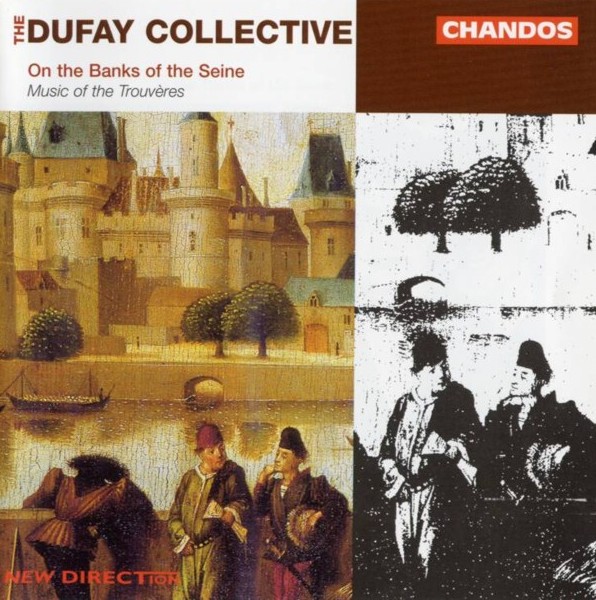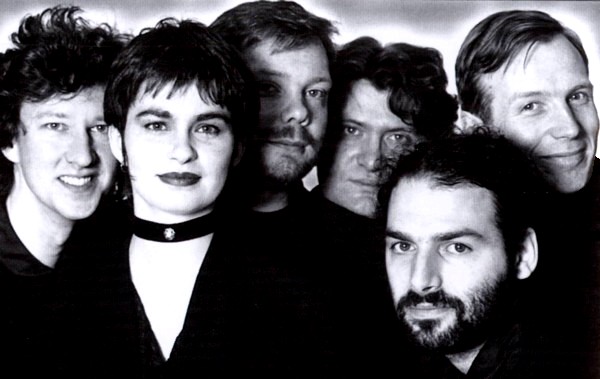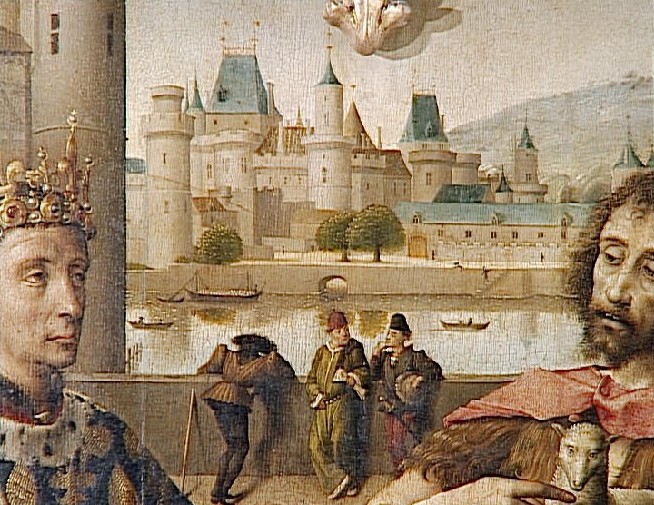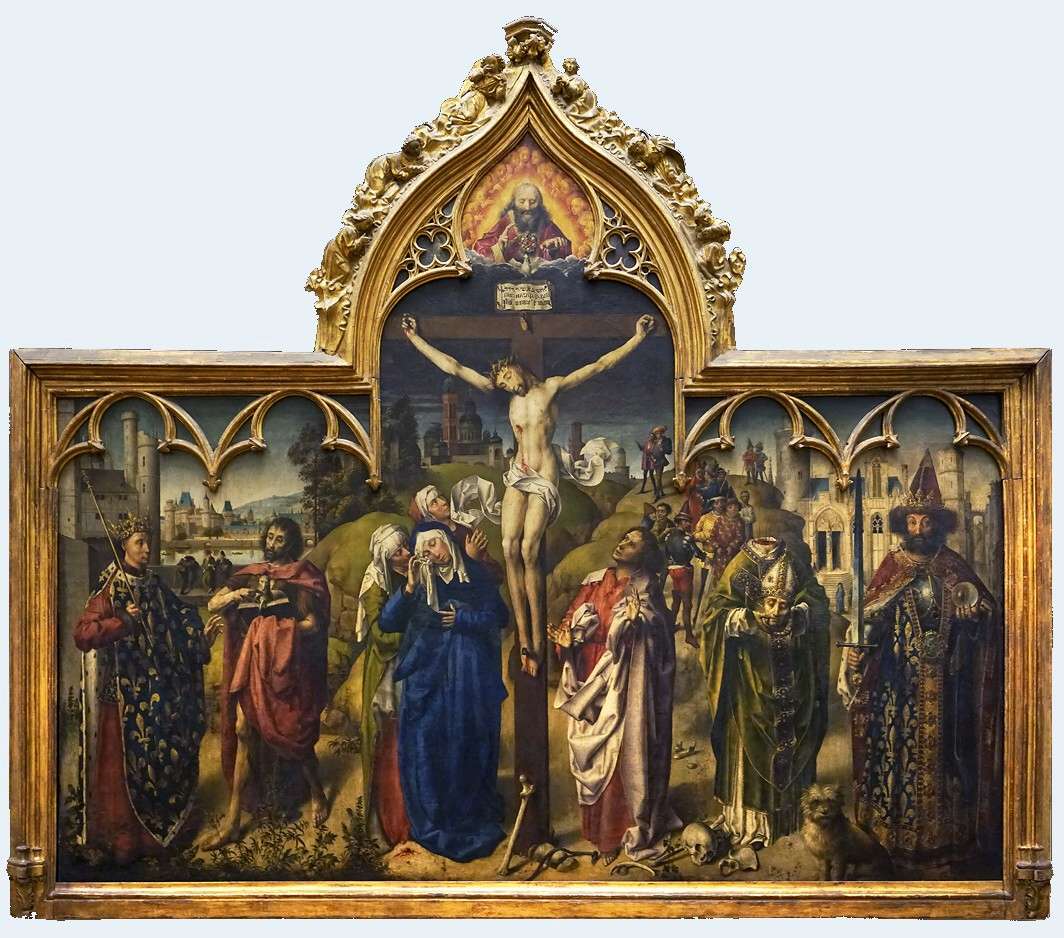On the Banks of the Seine. Music of the Trouvères
The Dufay Collective

medieval.org
Chandos 'New Direction' 9544
1997
1. Thibaut de CHAMPAGNE. J'aloie l'autrier [1:32]
dance | shawm, long trumpet
Guillaume d'AMIENS
2. Ses tres dous regars [1:14]
3. C'est la fins [1:29]
4. Prendés i garde [1:32]
Vivien Ellis, tutti (refrains)
5. Pucelete ~ Je languis ~ DOMINO [0:58]
6. On parole ~ A Paris ~ Frése nouvele [0:59]
voices G P W
7. Jehan BODEL. Les uns pins [4:03]
dance | 2 vielles, lute, recorder P, portative organ, symfony
8. Volex vous que je vous chant [3:18]
Vivien Ellis
9. La septieme estampie Real [2:58]
harp, lute, psaltery, gittern
Adam de la HALE
10. A Dieu commant amouretes [1:25]
11. A jointes mains vous proi [0:49]
12. Hé Dieus, quant verrai [0:43]
13. Tant con je vivrai [1:32]
14. Fines amouretes [2:26]
voices G P W
15. La douçours del tens novel [7:06]
Vivien Ellis, tutti (refrains), harp
16. La douçours [1:44]
dance | vielle, 2 recorders W P
17. En ung vergier [2:11]
2 bagpipes
18. Adam de la HALE. Dame or sui traïs [1:22]
voices G P W
19. Chanter voel par grant amour [3:52]
Vivien Ellis
20. Quant voi la flor nouvele [1:47]
flute, vielle G
21. L'autre jour par un matin [1:49]
22. Amor potest [1:29]
3 recorders
23. Adam de la HALE. Dieus soit en cheste maison [2:02]
voices G P W
24. MONIOT de Paris. Je chevauchoie l'autrier [4:29]
Vivien Ellis, vielle G
25. Je chevauchoie l'autrier [4:17]
dance | 2 vielles, lute, harp, psaltery, symfony

THE DUFAY COLLECTIVE
P — Paul Bevan, long trumpet, recorder, psaltery, voice
G — Giles Lewin, vielle, gittern, recorder, bagpipes, voice
W — William Lyons, flute, recorder, shawm, bagpipes, symfony, voice
Susanna Pell, vielle
Peter Skuce, harp, portative organ
with
Vivien Ellis, soprano voice
Jacob Heringman, lute
The Dufay Collective
was formed in 1987 to explore the wealth of music from the Middle Ages and the Renaissance.
Sell-out performances in London's concert halls and major festivals throughout Europe, Russia, Hong Kong,
Australia, the USA, South America and the Middle East have established the group as one of Europe's
finest early music ensembles. They have also made numerous radio, film and television appearances.
The Dufay Collective aims to present concerts that are both informative and innovative,
recreating the variety of instrumental and vocal styles heard throughout this rich and colourful age.
The individual members' versatility and virtuosity has won critical acclaim and the enthusiasm
of audiences worldwide.
INSTRUMENTS
· vielles — James Bisgood, 1982 / Gary Bridgewood, 1988
· lute — Daniel Larson, 1996
· gittern — Tom Eve, 1980
· psaltery — Colin Booth, 1975
· harp — Tim Hoborough, 1993
· simfony — Samuel Palmer, 1980
· shawm — Linsey Pollack, 1991
· bagpipes — Josť Reboredo, 1993; Bill O'Toole, 1975
· trumpet — Nicholas Perry, 1993
· recorders — Moeck, Germany, 1978, 1980, 1987
· flute — traditional India
· portative organ Maunders, London, 1980

sources:
#1, 8, 20, 24 — Paris, Bibliothèque de l'Arsenal, 5198
[1 reconstructed, MS Wallony II, No. 572.945 f142v]
#2-4 — Rome, Bibliotheca Vaticana 1490
#5, 6, 21, 22 — Montpellier Codex
#7 — fragment "Chanson de sabor" col. ess. Co 28; hq/Blackshaw 26
#9 — F-Pn fr. 844 f.104v
#10-14, 18, 23 — PBN fr25566 f33r-34r
#15, 17 — PBN fr.20050 f58v-f59r/65v-66r
#16, 25 — [fragment], L'eglise France [wins.] 311256 f40v
#19 — Paris, Arsenal 3517, f147r
Producer, Adrian Hunter
Sound engineer, Nicholas Parker
Assistant engineer, Richard Smoker
Editor, Ben Connellan
Recording venue, Oxford Church; 1—3 October 1996
Front cover: Detail from Retable du Parlement de Paris, milieu du XVe siècle
(Réunion des musées nationaux, France)
Desing, Penny Lee
Booklet typeset by Dave Partridge
Ⓟ 1997 Chandos Records Ltd
© 1997 Chandos Records Ltd
Chandos Records Ltd, Colchester, Essex, England

On the Banks of the Seine
The
name 'trouvère' is largely used to define those poets and musicians who
lived, worked and wrote in the northern part of France during roughly
the twelfth to the fourteenth centuries. No single language united the
many poets and composers, rather there was a series of local dialects
from Champagne, Picardy, Normandy and England. Like their southern
counterparts, the 'troubadours', the trouvères came from diverse social
backgrounds, from the sons of weavers to noble kings. These poets were
steeped in the courtly poetic tradition in much the same way as the
troubadours, and their notion of fine amours (refined love) was discernible as that of the fin amors of the southern poets.
Poetic
genres were also common to both. Of the 2100 poems, mostly with music,
that survive in the great trouvère chansonniers, the pastourelle (pastorela) is particularly well represented, as is the jeu parti (joc parti). The sirventes seems however to have fallen out of fashion, and a new form, that of the chanson avec refrain appears popular among the northern poets. The chanson pieuse (devotional song) was common, and the chanson de recontre (knight meets lady) similar in both cultures.
The
jewel of trouvère culture was the burgeoning city of Paris, whose
university and Cathedral of Notre Dame were to define and shape musical
philosophy and development for the whole of Europe in the Middle Ages.
By
the mid-thirteenth century Paris was at the peak of its cultural
influence in Europe. The University was expanding, physically and
aesthetically, embracing wider disciplines, and in the new Cathedral of
Notre Dame the development of polyphony as a grand device for use in
Mass and Office proper was gradually, through the expansion of conductus
and clausulae, moving into the secular world with the composition of
the first secular motets in the vernacular. In the University, music
theorists benefited from such a stimulating environment, producing some
of the most significant writers on music of the Middle Ages: Jerome of
Moravia, Johannes de Grocheo, Johannes de Garlandia, Franco of Cologne,
Anonymous IV and Jacques de Liège.
The fact that such flourishing
centres of learning were situated in an equally thriving urban setting
could not be ignored. As humanist philosophy gained favour in the
University, and with the secularization of some of the academic posts,
so attention to the real world of city life grew. Grocheo in his De Musica
gives a unique view of the sociological aspects of Parisian musical
life, and by examining sermons preached in this period we see the Church
slowly being forced to accept secular entertainment, and even attempt
to justify it from a theological basis. Faced with an environment of a
well-populated city full of every vice under the sun, clergymen began to
find positive reasons for such vices as dancing and itinerant
minstrelsy.
As well as the courtly poet musicians, there were the 'professional' minstrels, or jongleurs
who would frequent in large numbers a city such as Paris, where regular
employment was to be had. It was the sight of these importuning
boasters hawking their talents that so appalled the sermonizers. Fierce
competition meant the itinerant jongleur would have to adopt 'hard-sell'
tactics - advertising his ability to be versatile on any number of
instruments, and his talents as a singer, dancer and juggler. Minstrels,
like trouvères could also come from diverse backgrounds. In an
intriguing reminiscence on life in Paris circa 1200, the theologian and
chronicler Jacques de Vitry tells of a student who desires to become a
jongleur 'thrusting himself up to others and refusing to do proper
work'. Such an educated man may well have been versed in reading musical
notation, been a trained singer and even have some knowledge of the
composition and performance of polyphony.
However exceptional
this anecdote may have been, it appears that by the late thirteenth
century urban musicians were beginning to feel the need to organize
themselves and regulate their activities. Street names in
thirteenth-century Paris attest to the fact that there were defined
areas where musicians could be located and hired, 'Vicus Viellatorum',
'Vicus Joculatorum' and most importantly the 'Rue des Menestrels' or
'Rue aus Jongleurs'. This latter was the street whose inhabitants drew
up a statute of eleven articles in 1321 for ratification of their
profession and for 'the common profit of the city of Paris'. This list
of eleven rules for musicians intending to work in Paris contradicts
some of the accepted behaviour of the minstrel. For instance, it is
ruled in statute five that:
No apprentice minstrel who goes to a
tavern may advertise himself or any other minstrel, nor make any mention
of his trade or praise it...
Other statutes demand:
No trumpeters or other minstrels may leave a feast before it is finished.
And:
A minstrel who has been hired may not send a deputy except in the case of sickness,
imprisonment or other necessity.
Suddenly
there is a code of practice for those previously classed as
unscrupulous vagabonds - entirely appropriate in an environment crowded
with able performers seeking to earn their crust.
In courtly settings the chansons
of the trouvères would most likely have been performed without the
accompaniment of an instrument, or with one vielle or harp, played
either by the performer or a jongleur. Songs such as the pastourelle
would most likely have been performed rhythmically. The polyphonic
rondeaux of Adam de la Hale and the motet repertoire have been
considered until recently to have been the intellectual entertainment
for 'learned men'. This exclusivity has now been brought into question,
justifiably so, considering the straightforward nature of the texts (of
the rondeaux), and the fact that like Vitry's jongleur student, minstrels could easily come from a literate background.
Dance
music for courtly settings would have consisted largely of an
improvised or aurally transmitted corpus of tunes. The courtly dance par excellence of the Middle Ages, the estampie would most likely have been common, played on the bas instruments: vielles, harps, lutes and gitterns. When outdoors, the louder (haut)
instruments (shawms, bagpipes and even trumpet) would possibly have
performed dances based on popular tunes. For the great social dance of
the city, the carole, stringed or wind instruments seem to have
been used, or, as commonly depicted, the song and refrains were led by a
female, with responses by the other circling dancers.
Some talk of threshing and winnowing,
And digging and labouring.
But these joys
Aren't my delight;
For there's no life
Like being in comfort,
With good clear wine and capons,
And being with good companions,
Merry and rollicking,
Singing and joking and amorous,
And having all you need
To pleasure
Fair ladies to your heart's content.
And all this you find in Paris.
(from the motet On parale / A Paris / Frése nouvele)
William Lyons © 1997 The Dufay Collective





